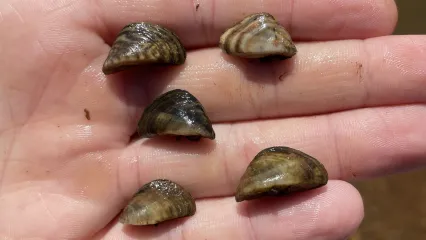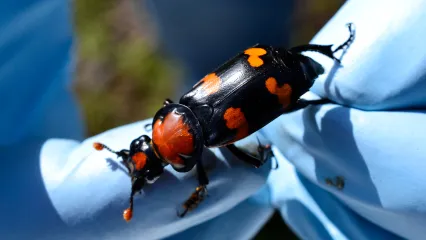
Description
The Ouachita rock pocketbook is a freshwater clam that has a shell length of approximately 4.5 inches, with a shape that can be described as moderately inflated and rounded. The color of the shell can vary from dark brown to black.
The construction of dams for the creation of reservoirs has negatively affected this clam. The operation and maintenance of reservoirs causes direct loss of habitat and alters river conditions for several miles downstream. Other threats to this species include river channelization, water pollution, sedimentation, agricultural runoff, and direct disturbance of mussel beds from human activity. The Wildlife Diversity Program has funded two research and recovery grants for this species through ESA Section 6 funding. The first project began in 1990 with the University of Oklahoma and was focused on researching habitat use and reproductive biology of the species. In 2011, the Wildlife Department began partnering with Missouri State University to investigate ways to propagate and raise Ouachita rock pocketbook mussels in a laboratory setting. Attempts have been made to collect glochidia from adult reproductive female mussels taken from below the Millwood Reservoir in Arkansas during the winter. Thus far, traditional mussel rearing techniques on host fish have been unsuccessful. New techniques are currently under development that do not require a fish host. Assuming additional glochidia can be obtained and successfully raised, the young mussels will be placed in soft-release “cages” into the Little River to assist in augmenting the small population in that river system. The Little River National Wildlife Refuge, owned by the U.S. Fish and Wildlife Service, encompasses a segment of the Little River. As a result, many important mussel beds containing Ouachita rock pocketbooks are protected.
Size
Approximately 4.5 inches in length.
Habitat
The Ouachita rock pocketbook occurs within the Kiamichi and Little rivers in southeast portion of the state. The Kiamichi River population is thought to be the largest and most stable, but contains less than 1,800 individuals. No more than 200 individuals are believed to occur in the Little River in Oklahoma. Ouachita rock pocketbooks can be found mixed with other mussel species in aggregations called mussel beds. These beds are often located on stable substrates composed of sand and gravel and are usually in areas of slower moving currents or backwaters of the river channel. The Ouachita rock pocketbook is found in very low densities, making up a fraction of one percent of the mussel community of the rivers in which it occurs.
Life Cycle
Mussels are filter-feeders, meaning they feed by filtering microscopic organisms and organic particles out of the surrounding water. The reproductive cycle of the Ouachita rock pocketbook has multiple stages, including a parasitic juvenile stage. After males release sperm into the water column, downstream females take the sperm in and fertilize their eggs. The eggs develop into larvae known as glochidia, which are released in winter and must reach the gills of a fish host. The Ouachita rock pocketbook will use multiple fish species as larval hosts to survive, including freshwater drum and golden shiners. After several weeks on host fish, the glochidia metamorphose into tiny mussels and drift to the bottom of the river where they may grow into adult mussels.


